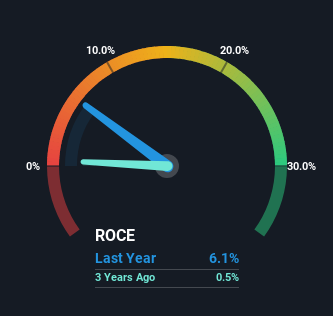- Germany
- /
- Commercial Services
- /
- DB:TUR
Returns On Capital Are Showing Encouraging Signs At Turbon (FRA:TUR)

Finding a business that has the potential to grow substantially is not easy, but it is possible if we look at a few key financial metrics. Amongst other things, we'll want to see two things; firstly, a growing return on capital employed (ROCE) and secondly, an expansion in the company's amount of capital employed. Ultimately, this demonstrates that it's a business that is reinvesting profits at increasing rates of return. With that in mind, we've noticed some promising trends at Turbon (FRA:TUR) so let's look a bit deeper.
Return On Capital Employed (ROCE): What Is It?
Just to clarify if you're unsure, ROCE is a metric for evaluating how much pre-tax income (in percentage terms) a company earns on the capital invested in its business. The formula for this calculation on Turbon is:
Return on Capital Employed = Earnings Before Interest and Tax (EBIT) ÷ (Total Assets - Current Liabilities)
0.061 = €2.1m ÷ (€46m - €11m) (Based on the trailing twelve months to December 2023).
So, Turbon has an ROCE of 6.1%. In absolute terms, that's a low return and it also under-performs the Commercial Services industry average of 11%.
View our latest analysis for Turbon

Historical performance is a great place to start when researching a stock so above you can see the gauge for Turbon's ROCE against it's prior returns. If you're interested in investigating Turbon's past further, check out this free graph covering Turbon's past earnings, revenue and cash flow.
So How Is Turbon's ROCE Trending?
Turbon has recently broken into profitability so their prior investments seem to be paying off. The company was generating losses five years ago, but now it's earning 6.1% which is a sight for sore eyes. Not only that, but the company is utilizing 23% more capital than before, but that's to be expected from a company trying to break into profitability. This can tell us that the company has plenty of reinvestment opportunities that are able to generate higher returns.
One more thing to note, Turbon has decreased current liabilities to 23% of total assets over this period, which effectively reduces the amount of funding from suppliers or short-term creditors. This tells us that Turbon has grown its returns without a reliance on increasing their current liabilities, which we're very happy with.
The Key Takeaway
To the delight of most shareholders, Turbon has now broken into profitability. And given the stock has remained rather flat over the last five years, there might be an opportunity here if other metrics are strong. So researching this company further and determining whether or not these trends will continue seems justified.
On a separate note, we've found 3 warning signs for Turbon you'll probably want to know about.
If you want to search for solid companies with great earnings, check out this free list of companies with good balance sheets and impressive returns on equity.
If you're looking to trade Turbon, open an account with the lowest-cost platform trusted by professionals, Interactive Brokers.
With clients in over 200 countries and territories, and access to 160 markets, IBKR lets you trade stocks, options, futures, forex, bonds and funds from a single integrated account.
Enjoy no hidden fees, no account minimums, and FX conversion rates as low as 0.03%, far better than what most brokers offer.
Sponsored ContentValuation is complex, but we're here to simplify it.
Discover if Turbon might be undervalued or overvalued with our detailed analysis, featuring fair value estimates, potential risks, dividends, insider trades, and its financial condition.
Access Free AnalysisHave feedback on this article? Concerned about the content? Get in touch with us directly. Alternatively, email editorial-team (at) simplywallst.com.
This article by Simply Wall St is general in nature. We provide commentary based on historical data and analyst forecasts only using an unbiased methodology and our articles are not intended to be financial advice. It does not constitute a recommendation to buy or sell any stock, and does not take account of your objectives, or your financial situation. We aim to bring you long-term focused analysis driven by fundamental data. Note that our analysis may not factor in the latest price-sensitive company announcements or qualitative material. Simply Wall St has no position in any stocks mentioned.
Have feedback on this article? Concerned about the content? Get in touch with us directly. Alternatively, email editorial-team@simplywallst.com
About DB:TUR
Turbon
Engages in the development, production, and sale of typeface printing accessories in Europe, the United States, and Asia.
Flawless balance sheet moderate.
Market Insights
Community Narratives



